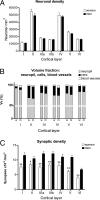Gender differences in human cortical synaptic density
- PMID: 18779570
- PMCID: PMC2567215
- DOI: 10.1073/pnas.0803652105
Gender differences in human cortical synaptic density
Abstract
Certain cognitive functions differ in men and women, although the anatomical and functional substrates underlying these differences remain unknown. Because neocortical activity is directly related with higher brain function, numerous studies have focused on the cerebral cortex when searching for possible structural correlates of cognitive gender differences. However, there are no studies on possible gender differences at the synaptic level. In the present work we have used stereological and correlative light and electron microscopy to show that men have a significantly higher synaptic density than women in all cortical layers of the temporal neocortex. These differences may represent a microanatomical substrate contributing to the functional gender differences in brain activity.
Conflict of interest statement
The authors declare no conflict of interest.
Figures


References
-
- Linn MC, Petersen AC. Emergence and characterization of sex differences in spatial ability: A meta-analysis. Child Dev. 1985;56:1479–1498. - PubMed
-
- Kimura D. Sex and Cognition. Cambridge, MA: MIT Press; 2000.
-
- Bocklandt S, Vilain E. Sex differences in brain and behavior: Hormones versus genes. Adv Genet. 2007;59:245–266. - PubMed
-
- Davies W, Wilkinson LS. It is not all hormones: Alternative explanations for sexual differentiation of the brain. Brain Res. 2006;1126:36–45. - PubMed
Publication types
MeSH terms
LinkOut - more resources
Full Text Sources
Molecular Biology Databases

